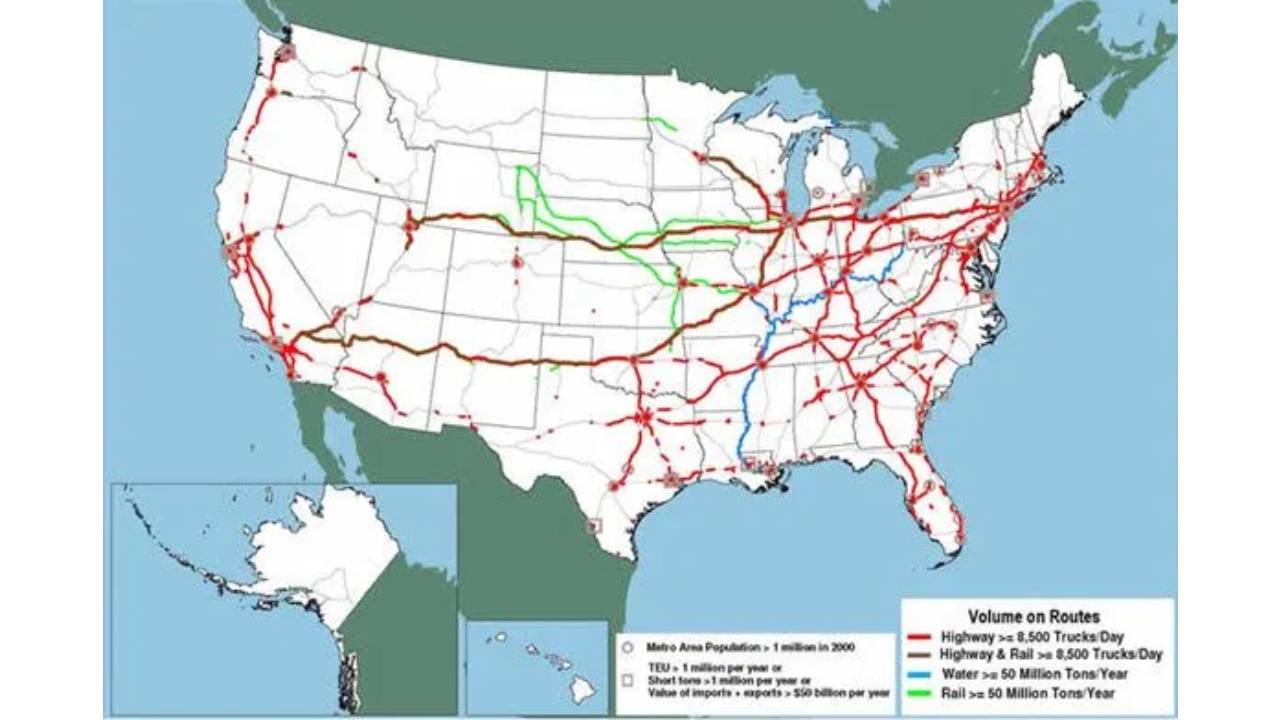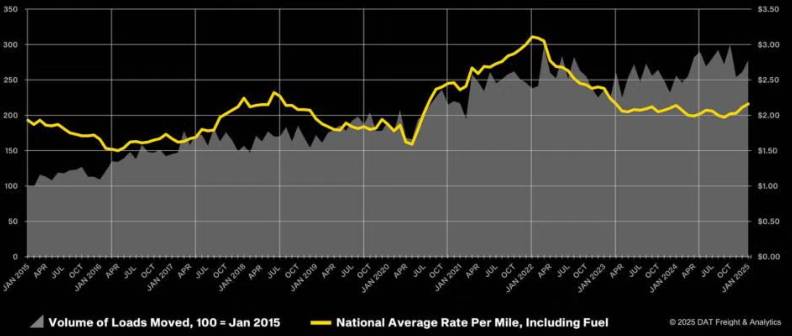
Are Trucking Dispatchers in Demand?
31 August, 2025
U.S. dispatcher demand explained: market trends, pay ranges, required ...
Read
Learn latest news about Trump Tariffs
Content:
Impact of Trump’s 2025 Tariffs on U.S. Truck DispatchersThe Trump administration’s sweeping 2025 tariff plan – including a 145% duty on Chinese imports and 25% on many Canadian and Mexican goods – abruptly reshaped freight flows in the U.S. trade and logistics network. Cargo volumes jumped in early 2025 as importers pulled in goods ahead of the tariffs, but industry analysts warned that this surge would quickly reverse. By spring, ports reported steep drops in Asian imports: Los Angeles port officials predicted a 35% plunge in arrivals within weeks of the tariff deadline. In practice, many major retailers halted shipments from China, cutting port volume and signaling fewer loads for trucks.
In January–March 2025, dispatchers saw a spike in load inquiries as customers rushed to import before tariffs took effect. Shippers “pulled forward” orders onto the spot market to beat the April 2 deadline. DAT Freight & Analytics reported that spot truckload volume indices in January and March were well above year-ago levels (e.g. January volumes up 8% YOY). For example, winter weather aside, the DAT Van Freight Volume Index climbed from 277 in January to 287 by April (2015=100 baseline) before easing. Carriers briefly enjoyed tight capacity and higher spot rates (van rates rose to ~$2.16/mile in January) due to the surge.
However, this “pull-forward” effect meant little new demand to sustain those volumes. DAT notes that shippers tapping existing inventory for spot moves left “overall freight volumes [flat]” by April. In other words, the January–March boom was largely one-time stockpiling. By late spring, industry data showed freight demand softening: U.S. truckload volumes had returned to roughly year-ago levels. Freight forecasting firms noted that the tentative ATA projection of +1.6% volume growth for 2025 had already been wiped out by tariff uncertainty.
Tariffs triggered notable swings in cross-border trucking. Ahead of the March deadline for 25% Mexico/Canada duties, Canadian importers jammed freight into the U.S., sending DAT spot rates to two-year highs. For example, Toronto–Chicago loadings jumped 57% in one week before March, and refrigerated loads from Mexico through Laredo rose 35% to the Pharr, TX market. As one DAT analyst put it, “shippers north of the border were desperate” to clear shipments into the U.S. before tariffs imposed.
Once the tariffs were live, that trend flipped. Freight between Canada and the U.S. slowed dramatically: the Port of Los Angeles saw a 35% drop in Asian cargo within weeks, and analysts predict a sharp decline in Canada-to-U.S. truckloads. Economists warned that stalled manufacturing demand and higher import costs would “dampen demand even further and therefore reduce truckload volumes”. For dispatchers, this meant suddenly fewer cross-border loads to assign and more competition for remaining freight. (A related issue was the 90-day tariff pause on USMCA-compliant goods, which eased some Canada/Mexico strain but didn’t prevent overall volume declines.)
The net effect was a roller-coaster for dispatch desks. In Q1 2025 many dispatchers were stretched thin, coordinating frantic last-minute shipments and constantly checking new trade rulings. But by Q2 their pipelines thinned. The Los Angeles Times reported that Southern California truckers – who haul about 40% of U.S.–Asia freight – began hearing rumors of a “sharp decline” in incoming loads for May and June. One port study estimated that a mere 1% drop in volume at LA/LB ports could cost nearly 2,800 jobs. At the driver level, dispatchers noted individual fleets cutting runs: “If you’re a trucker hauling four or five containers today, you may haul two or three in the future,” the Port of LA’s executive director warned.
As loads fell, dispatcher demand fell too. Charting industry anecdote, one can imagine a dispatcher-demand index (with Jan=100) sliding by mid-2025 (see below). In practice, some smaller dispatch brokers reported losing accounts and merging operations. Larger logistics firms announced layoffs: UPS, for example, cited Trump’s tariffs as a factor while cutting 20,000 jobs in April 2025. In trucking, industry leader Knight-Swift said shippers became more cautious under tariff uncertainty. Such belt-tightening inevitably rippled down to owner-operators and dispatch services, reducing load opportunities and squeezing dispatcher revenues.
On the revenue side, rate pressure was mixed. Spot truck rates in January–April held steady or fell slightly as the spot market briefly over-supplied relative to contract loads. Carriers did achieve some rate increases in contract deals during the early-year rush, but analysts warn those gains may evaporate as volume softens. FreightWaves and Reuters note that the 2025 spot rate forecast was trimmed in light of tariff uncertainty. One large carrier CEO admitted that momentum was “at risk if volumes…remain weak” reuters.com. In short, dispatchers saw little relief in prices: the rise in contracted freight rates was barely enough to cover higher fuel and equipment costs already imposed by tariffs on inputs (like steel).
In practical terms, dispatcher revenue fell with fewer loads to broker. Fewer loads per week means each dispatcher earns less commission or fee. Competition for available freight also intensified, especially among independent dispatchers and small 3PLs. Sources report that many dispatchers found themselves quoting ever-lower margins just to win scarce loads. Because the tariffs also raised carriers’ input costs (trucks, parts, fuel, etc.), the dispatcher community braced for an industry shakeout. Some seasoned dispatchers counseled newcomers to diversify clients and practice tight cost control during the downturn.
One striking example came from Mariner Logistics in Texas, a freight forwarding and dispatch firm. In late March, Mariner’s international team worked around the clock to rush a $800,000 aircraft engine shipment from Canada into the U.S. just hours before the new 25% tariff kicked in freightwaves.com. According to Mariner’s VP of international logistics, clients were adamant: even an extra 20–25% duty was “unsustainable” for their business. This single operation – coordinating a complex heavy load on short notice – likely fell to Mariner’s dispatch and operations staff. Situations like this were echoed nationwide: dozens of dispatch desks reported “fire-drills” of cross-border rerouting in March. However, once deadlines passed, those surges vanished. By late spring many brokers said their daily load boards were noticeably thinner.
Another dispatch-centric example involved rate fluctuations at the U.S.–Mexico border. A Reuters analysis found that Dallas/Fort Worth–Laredo carriers saw a sharp uptick in Mexican freight loads just before tariffs hit. Truck brokers in Laredo and Pharr noted spike in produce and automotive shipments into the U.S. (as NAFTA-origin goods were exempt temporarily). But once the pause on most USMCA goods expired in May, even these lanes slowed. Dispatch coordinators observed that shipments from Mexico leveled off or fell slightly month-over-month after spring.
While UPS CEO Carol Tomé cautioned that new tariffs risked disrupting over a century of established trade flows , the broader freight ecosystem has shown remarkable resilience. Although equipment orders dipped briefly and spot market quotes softened in Q2
FreightWaves, the American Trucking Associations still projected a moderate rebound for 2025, and even amid forecasts of flat or slightly negative volume growth due to trade barriers, dispatchers rose to the challenge with ingenuity and determination. Most industry analysts view these tariff impacts as temporary. As short-term trade truces spur a surge in import bookings before key seasons and port volumes climb, strong U.S. consumer demand remains the bedrock of freight activity. Looking ahead, policy adjustments and ongoing negotiations are expected to usher in a recovery in late 2025. In the meantime, dispatchers who embrace dedicated lanes, digital load boards, and proactive rerouting strategies can not only sustain operations but also seize new opportunities in shifting domestic markets. For students and new dispatchers, this environment underscores the importance of understanding macroeconomic forces and honing adaptive logistics skills. Developing expertise in capacity planning, dynamic routing, and carrier communication will position you at the forefront of the industry. To build these capabilities quickly, consider enrolling in the Trucking42 Dispatch Course - https://trucking42.school/dispatch-course, which offers hands-on training in planning and adaptation for today’s most volatile freight markets

The map above shows major North American freight corridors and ports . Notice how Los Angeles/Long Beach, Laredo (TX-MX border), and Detroit/Toronto are focal points. These were precisely the lanes hardest hit by the new tariffs: LA/LB saw collapsing Asian loads, Laredo and Detroit corridor traffic surged then tumbled, and flows through Chicago to/from Canada lagged dramatically post-tariff. By studying such maps, dispatchers can anticipate where rerouting or new routing may be needed when cross-border volumes shift.

Spot truckload volume index (DAT) Jan–Jun 2025. Freight volumes spiked in early 2025 as shippers pulled in inventory ahead of tariffs, then fell sharply by mid-year once tariff impacts took hold. (https://www.dat.com/company/news-events/news-releases/dat-uncertainty-looms-despite-a-steady-january-for-truckload-freight)
For a deeper explanation of how tariffs ripple through supply chains, see this expert discussion: “Tariff Supply Chain Impact with FreightWaves CEO Craig Fuller” on YouTube (FreightWaves, May 2025). In that video, Fuller and supply chain analysts outline how sudden import duties distort purchasing, inventory and transport planning. Watching logistics-focused commentary can help dispatchers grasp the strategic context behind current market swings. (Video: https://www.youtube.com/watch?v=IUObg_UaDuc)
By keeping an eye on vetted data and industry reports, a truck dispatcher can better manage routes, communicate rate expectations, and even suggest alternative strategies (e.g. intermodal or warehousing) to clients. The case of 2025 shows dispatchers are on the front lines of international policy effects: workloads and revenues will ebb and flow with these larger trends.
Sources: Data and analysis are drawn from industry-trusted reports (USTR, CBP, ATA), FreightWaves and Reuters logistics coverage, and sector indices (DAT, Cass) that track freight volumes. These sources ensure facts on tariffs and freight demand are up-to-date and rigorous. This report synthesizes their findings to explain the tariff impacts specifically for truck dispatching professionals.
Similar articles

31 August, 2025
U.S. dispatcher demand explained: market trends, pay ranges, required ...
Read

31 August, 2025
Discover which trucking roles pay the most. Learn about high-earning j ...
Read

31 August, 2025
Truck dispatcher vs. truck driver: salaries, perks, schedules, and gro ...
Read